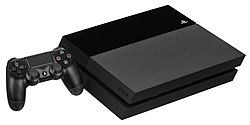 | |
 The original PlayStation 4 console with the DualShock 4 controller | |
| Developer | Sony Interactive Entertainment |
|---|---|
| Manufacturer | Sony Electronics, Foxconn [1] |
| Product family | PlayStation |
| Type | Home video game console |
| Generation | Eighth |
| Release date | |
| Introductory price | |
| Discontinued |
|
| Units sold | >113.5 million (as of September 30,2020 [update] ) [6] |
| Units shipped | 117.2 million (as of March 31,2022 [update] ) [7] |
| Media | |
| Operating system | PlayStation 4 system software |
| System on a chip | AMD APU |
| CPU | AMD Jaguar, 8-core @ 1.6 GHz (2.13 GHz on PS4 Pro) [8] Secondary low power processor (for background tasks) [9] |
| Memory | |
| Storage | 500 GB, 1 TB or 2 TB HDD [10] |
| Display | |
| Graphics | |
| Controller input | DualShock 4, PlayStation Move, PlayStation Vita |
| Camera | PlayStation Camera |
| Connectivity |
|
| Online services | |
| Dimensions |
|
| Weight |
|
| Best-selling game | Marvel's Spider-Man (20 million) |
| Predecessor | PlayStation 3 |
| Successor | PlayStation 5 |
| Website | playstation |
The PlayStation 4 (PS4) is a home video game console developed by Sony Interactive Entertainment. Announced as the successor to the PlayStation 3 in February 2013, it was launched on November 15, 2013, in North America, November 29, 2013, in Europe, South America, and Australia, and on February 22, 2014, in Japan. A console of the eighth generation, it competes with Microsoft's Xbox One and Nintendo's Wii U and Switch.
Contents
- History
- Hardware
- Technical specifications
- Controllers
- Camera
- PlayStation VR
- Software and services
- PlayStation 4 system software
- Multimedia features
- PlayStation Network
- Second screen and remote play
- Social features
- Community creation
- Media sharing
- Live streaming
- Share Play
- Games
- Backward compatibility
- PlayStation Now
- PlayLink
- Release
- Critical reception
- Sales
- Hardware revisions
- PlayStation 4 Slim
- PlayStation 4 Pro
- Notes
- References
- External links
Moving away from the more complex Cell microarchitecture of its predecessor, the console features an APU from AMD built upon the x86-64 architecture, which can theoretically peak at 1.84 teraflops; AMD stated that it was the "most powerful" APU it had developed to date. The PlayStation 4 places an increased emphasis on social interaction and integration with other devices and services, including the ability to play games off-console on PlayStation Vita and other supported devices ("Remote Play"), the ability to stream gameplay online or to friends, with them controlling gameplay remotely ("Share Play"). The console's controller was also redesigned and improved over the PlayStation 3, with updated buttons and analog sticks, and an integrated touchpad among other changes. The console also supports HDR10 high-dynamic-range video and playback of 4K resolution multimedia.
The PlayStation 4 was released to critical acclaim, with critics praising Sony for acknowledging its consumers' needs, embracing independent game development, and for not imposing the restrictive digital rights management schemes like those originally announced by Microsoft for the Xbox One. Critics and third-party studios, before its launch, also praised the capabilities of the PlayStation 4 in comparison to its competitors. Heightened demand also helped Sony top global console sales. In September 2016, the console was refreshed with a new, smaller revision, popularly referred to as the "Slim" model, as well as a high-end version called the PlayStation 4 Pro, which features an upgraded GPU and a higher CPU clock rate to support enhanced performance and 4K resolution in supported games. By October 2019, PS4 had become the second best-selling PlayStation console of all time, behind the PlayStation 2. Its successor, the PlayStation 5, was released in November 2020; the PS4 continues to be produced as of 2025. [11]








